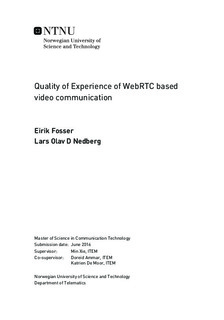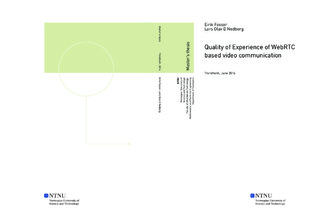| dc.description.abstract | Online video applications are growing in popularity and using an
increasing share of the consumer Internet traffic. Web Real-Time Communication (WebRTC) is a new technology which allows browser-to-browser
communications without any software downloads or user registration.
The focus of this report is the Quality of Experience (QoE) in the context
of WebRTC.
We have created a fully controllable testing environment, a testbed,
where we can manipulate a network to perform under various conditions
by altering the parameters packet loss rates, Mean Loss Burst Size
(MLBS), delay, jitter, Central Processing Unit (CPU), and bandwidth. A
testbed is of importance for testing of QoE services in general, and also
for application developers because they can analyze their application s
behavior in altered networks which can simulate real-world use.
We have used the WebRTC application appear.in for several different
experiments where we altered the network conditions. We have col-
lected both connection statistics and the subjective feedback from each
participant.
Firstly, we conducted a pilot study consisting of two-party conversa-
tions of 12 participants, where our main focus was on packet loss and
MLBS. After that, we conducted three-party conversations where we
tested packet loss, MLBS, delay, jitter, and CPU.
We found in our experiments that the perceived quality of a specific
packet loss rate depends also on the MLBS. Higher MLBS seems to result
in an overall worse user experience, especially impacting the audio quality
of the conversation. We also found that delay (<1 second) does not
necessarily leads to a worse user experience, while jitter quickly impacts
both audio and video quality. Finally, it seems that the CPU limitations
seem to affect only the user with the reduced CPU-usage.
The experiments show that the testbed is working as specified, and
can be used for more extensive research in the future.
Keywords - WebRTC, Quality of Experience, appear.in, testbed, pilot
study, Mean Loss Burst Size. | |

